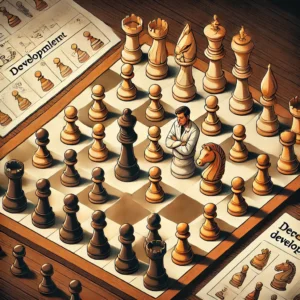Introduction

Mastering chess openings is crucial for beginners as it lays the foundation for strategic play throughout the game. By understanding beginner-friendly openings and basic principles, players can gain a significant advantage early on and set themselves up for success. This guide explores accessible chess openings, essential strategic concepts, and common pitfalls to help beginners navigate the opening phase with confidence and skill.
Basic Principles
Controlling the Center

- Importance:
- Central squares (d4, d5, e4, e5) are critical for piece mobility and attacking potential.
- Controlling the center allows for greater flexibility in maneuvering pieces and launching attacks.
- Strategy:
- Start by advancing central pawns (e4/d4 for White, e5/d5 for Black) to occupy key squares.
- Develop knights and bishops to squares that influence the center, preparing for future maneuvers.
Developing Pieces
- Key Ideas:
- Rapid piece development ensures pieces are active and contribute to the game’s flow.
- Pieces should aim for central squares initially to support control and facilitate effective coordination.
- Strategy:
- Knights and bishops should be developed towards central squares (e.g., Nf3/Nc3, Bc4/Bf4 for White).
- Avoid moving the same piece multiple times in the opening unless absolutely necessary to maintain tempo.
Ensuring King Safety

- Objective:
- Early kingside castling (O-O for White, O-O-O for Black) helps safeguard the king behind a wall of pawns.
- King safety ensures minimal exposure to threats, allowing focus on strategic and tactical goals.
- Strategy:
- Prioritize pawn structure integrity around the king, avoiding premature pawn advances that weaken defenses.
- Plan for timely castling while considering opponent threats and maintaining central control.
Common Pitfalls
Mistake: Neglecting Development

- Description:
- Beginners may delay or mishandle piece development, leading to a cramped position and limited options.
- Focusing too much on pawn moves or neglecting minor pieces hinders the ability to control the board effectively.
- Solution:
- Prioritize developing knights and bishops early, aiming for central squares to exert influence.
- Avoid excessive pawn moves that block or hinder piece mobility, ensuring each move contributes to overall development.
Mistake: Ignoring King Safety

- Description:
- Failing to castle timely exposes the king to potential threats, such as pawn storms or tactical attacks.
- A poorly defended king can become a target for opponent tactics and sacrifices.
- Solution:
- Plan for early kingside castling (O-O for White, O-O-O for Black) to secure the king behind a pawn shield.
- Evaluate opponent threats and adjust pawn moves to maintain a solid defense around the king.
Mistake: Overextending in the Center

- Description:
- Pushing too many pawns forward in the center without adequate support can lead to vulnerabilities and pawn weaknesses.
- Overextending can allow opponents to exploit gaps or launch counterattacks against exposed pawns.
- Solution:
- Advance pawns in the center cautiously, maintaining control without compromising pawn structure.
- Support advances with well-placed pieces and consider pawn advances that support central control rather than weaken defenses.
Mistake: Lack of Opening Knowledge

- Description:
- Beginners may lack familiarity with basic opening principles or specific variations, leading to suboptimal play.
- Not knowing typical plans or responses in a chosen opening can result in being caught off guard or falling behind in development.
- Solution:
- Study fundamental opening principles, including central control, piece development, and early king safety.
- Learn key opening variations and typical moves to anticipate opponent responses and maintain a strategic advantage.
Conclusion
Understanding and avoiding these common pitfalls in chess openings is crucial for beginners aiming to improve their game. By focusing on effective piece development, maintaining king safety, and adhering to basic opening principles, players can lay a strong foundation for success in the middlegame and beyond. Continuously learning from mistakes and refining opening strategies will contribute to overall chess proficiency and enjoyment of the game.
Visit our website chesstacticshub.com for more in-depth guides and resources to help you master every aspect of chess strategy.
